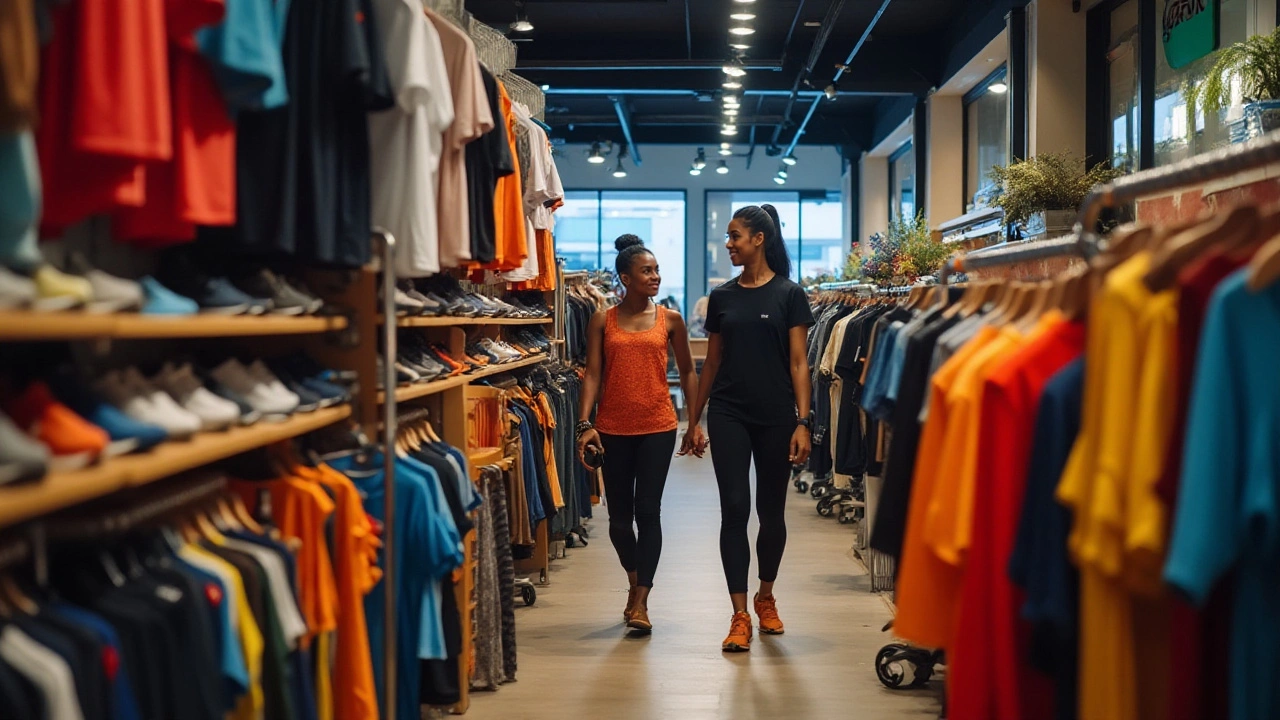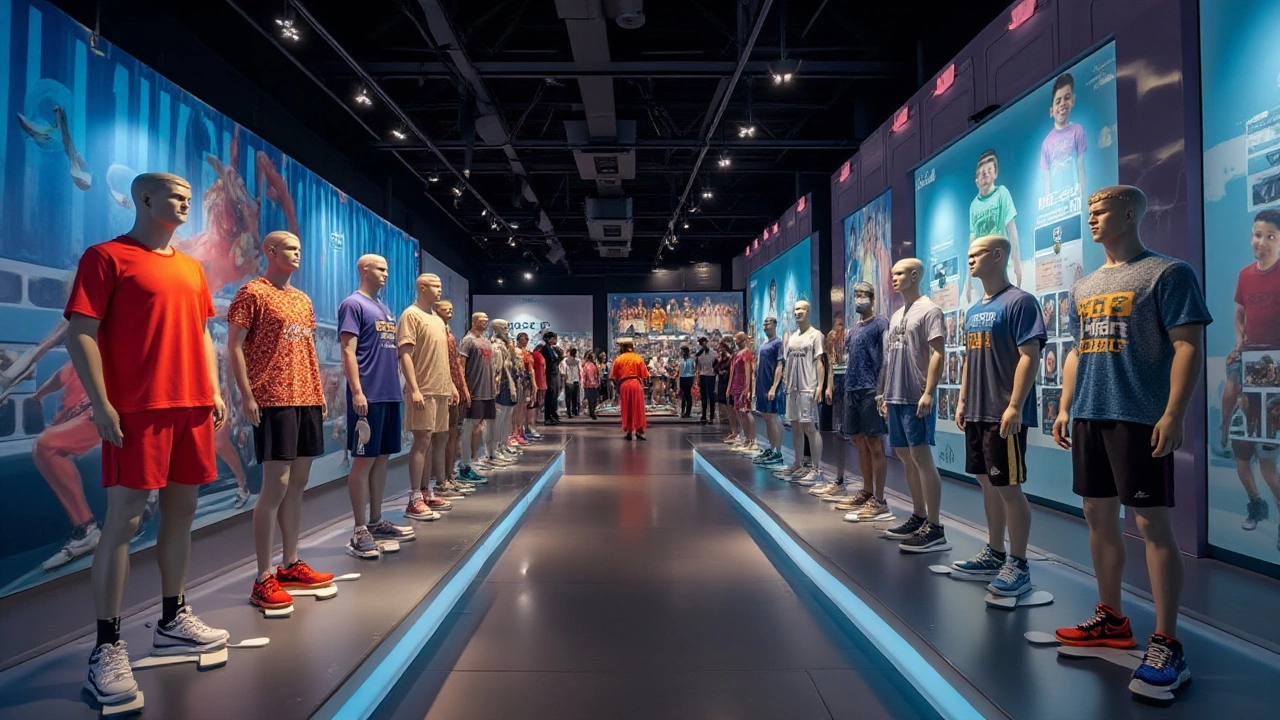Top Sportswear Brands: The Styles Dominating the Market in 2024

In the realm of sportswear, brand loyalty runs deep, driven by a mix of performance needs, style preferences, and cultural trends. With everything from classic athletic icons to disruptive newcomers vying for attention, knowing who's who in 2024 is essential for anyone wanting to stay ahead of the style and performance curve.
This exploration dives into the leading sportswear brands captivating consumers today. We delve into the timeless appeal of the industry's giants, the fresh flavors introduced by rising stars, and how these brands marry style with functionality. Sustainability and technology also take center stage, reflecting the growing demand for eco-friendly materials and cutting-edge innovations.
Whether you're an elite athlete or a casual morning jogger, the right sportswear can make all the difference. By the end of this journey, choosing the perfect brand for your lifestyle will be that much easier.
- The Everlasting Giants
- The Rising Stars
- Sustainability in Sportswear
- Fashion Meets Function
- Tech Integration in Sports Apparel
- Choosing the Right Brand for You
The Everlasting Giants
When it comes to sportswear brands that have withstood the test of time, names like Nike, Adidas, and Puma often come to mind. These giants have not only shaped the world of activewear but also played pivotal roles in sports culture and history. Nike, with its iconic swoosh, began as Blue Ribbon Sports in 1964 and revolutionized the industry by marrying high-performance with high-style. The advent of Air Max technology in the '80s set unprecedented standards, allowing athletes to reach new heights. Today, the brand continues to innovate, incorporating elements like Flyknit technology and recycled materials to meet contemporary demands.
Adidas, another staple, hails from Germany and boasts a history deeply intertwined with some of sports' most iconic moments. Think of the legendary three stripes and how they've graced the feet of countless Olympic champions. Their commitment to blending tradition with innovation is evident in their signature Boost technology, popular among elite runners and casual joggers alike. The brand's approach isn't just about performance; it's about creating a lifestyle that fans proudly wear outside the gym. Interestingly, Adidas has also been at the forefront of sustainability, introducing products like the Parley collection, which utilizes ocean plastic.
Puma, while often considered in the shadows of Nike and Adidas, plays a crucial role in the realm of sports apparel. Known for its bold designs and collaborations with fashion icons, it bridges the gap between sports and street style. Puma's journey from crafting soccer shoes in the mid-20th century to partnering with stars like Rihanna demonstrates their adaptability and commitment to stay relevant in a fast-paced world. Through its innovative designs and celebrity endorsements, Puma has carved out a distinct niche in the competitive landscape.
"These brands have not just survived; they have thrived by continuously rewriting the playbook and redefining what it means to be a giant in the industry." – Sports Illustrated.
It's not just their products that appeal; it's the stories they tell, the legacy they continue to build, and the communities they inspire. Whether it's through their impactful marketing campaigns or their inculcation of technology into the fabric (literally) of their products, these brands shape more than just the way people wear. They mold ideals, passions, and the relentless pursuit to be the best version of oneself. As we look towards a future teeming with new competitors, the staying power of these giants is rooted in their storied past and unwavering commitment to innovation.
Amidst an ever-evolving market, these brands uphold a legacy cemented by years of pioneering advancements and cultural impact. Their stories are marked by bold moves—like Nike’s decision to sign Michael Jordan, Adidas’ strategic sponsorships in soccer, and Puma’s influential partnerships with sports personalities. The reason for their enduring success is layered: a blend of groundbreaking technology, sharp marketing acumen, and a keen sense of cultural trends. This balance allows these giants to remain enduringly relevant, continuously captivating new generations of sportswear enthusiasts.
The Rising Stars
The sportswear market in 2024 is an exhilarating arena, teeming with dynamic new brands that are capturing the imaginations of fitness enthusiasts around the world. This fresh wave of activewear brands is not just about bold aesthetics; they're reimagining performance and sustainability in a quest to redefine what we expect from our sports clothing. Many of these rising stars are injecting their collections with a mix of technology-driven designs and eco-conscious practices. For instance, brands like PANGAIA have made waves with their innovative use of bio-based materials, ensuring that each garment speaks to both the fashion-forward and environment-conscious consumer.
Brands like Vuori and Gymshark are emblematic of this new era, growing immensely due to their direct connections with a younger, digitally-savvy customer base. Vuori, often described as laid-back yet stylish, epitomizes the Californian lifestyle, blending nuanced designs with performance fabrics that tick the boxes for any active individual. On the other hand, Gymshark has harnessed the power of social media influencers, creating a community-driven experience that is both aspirational and within reach. A quote from fashion analyst Jane Smith captures this dynamic perfectly:
"Today's sportswear brands need to be multi-faceted, offering not just apparel, but an entire lifestyle that resonates deeply with their consumers."
Another emerging contestant in the field of sports apparel is Allbirds, celebrated for its commitment to sustainability and unique offerings in the realm of sustainable sportswear. Allbirds takes pride in its innovative approach, creating a product line that is functionally efficient while maintaining a minimal carbon footprint. The company employs materials like Merino wool and tree fibers, efficiently blending comfort with eco-responsibility. These innovations are not just eco-friendly gestures but market-moving strategies aligning with customer demands for products that are kind to our planet. As a testament to its impact, a recent study indicated that 65% of consumers are more likely to purchase from brands that advocate sustainable practices.
Hem & Thread and Alo Yoga are other inspiring examples of fast-growing brands making significant marks in the industry. Alo Yoga is renowned for its premium yoga clothes and will invariably appeal to anyone drawn to both style and performance. Their design philosophy echoes contemporary aesthetics, which play equally well in a yoga studio and a casual brunch setting. Hem & Thread charts a slightly different course by focusing on inventive design and affordability, pushing the boundaries to democratize high-quality, fashionable activewear to a broader audience. It's an exciting moment where new players are challenging established paradigms, ensuring that the world of sportswear remains vibrant and competitive.

Sustainability in Sportswear
The current wave of sustainability in sportswear brands is no passing fad. A vast majority of companies now recognize their environmental impact and bear the responsibility to address these challenges head-on. Consumers are increasingly eco-conscious, requiring their favorite sports apparel not only to deliver on performance but also to harmonize with the planet's well-being. This shift has seen giants like Adidas and Nike incorporate recycled materials into their product lines. From ocean plastics to repurposed textiles, brands are showing that innovation and sustainability can walk hand in hand.
A compelling example is Adidas's collaboration with the environmental organization Parley for the Oceans, which led to the creation of shoes made entirely from recycled ocean waste. Nike has matched strides with its Move to Zero initiative, aiming for zero carbon and zero waste. These initiatives not only reduce environmental footprints but also foster consumer awareness, nudging us all towards more responsible choices. Remarkably, statistics show that as of 2023, Adidas has sold over 30 million pairs of Parley shoes, a testament to the growing consumer demand for sustainable options in activewear.
"It's about creating a sustainable loop, where every product is just one step in keeping materials in usage," commented James Carnes, vice president of Brand Strategy at Adidas, in a 2023 interview.
This evolving landscape is not limited to established players. Emerging brands like Patagonia have long championed environmental activism, with efforts such as transparent supply chains and commitment to Fair Trade certifications. Their business model illustrates that profitability and ethical practices are not mutually exclusive. Patagonia’s Worn Wear program, which encourages consumers to repair, share, and recycle old gear, is a wonderful illustration of a circular economy in action.
As consumers become more informed, the spotlight on sustainability in sports apparel will shine brighter. Future prospects suggest the integration of more sustainable fabrics like bamboo fibers and organic cotton, alongside innovations in waterless dyeing technologies. For anyone passionate about reducing their carbon footprint while maintaining their active lifestyle, the array of eco-friendly options available in sportswear brands continues to expand. While the road to comprehensive sustainability is a long one, the efforts seen today set a promising precedence for the industry and the planet.
Fashion Meets Function
The intersection where fashion and function blend seamlessly is where modern sportswear thrives. In 2024, activewear is no longer just about technical performance. It is an expression of personal style and identity, offering a canvas for self-expression while still serving its primary purpose of enhancing athletic performance. Leading brands in the sports apparel industry have adopted innovative designs that make athletes look as good as they feel, whether they are on the track or the street.
One of the key players in this fashion revolution is Nike, whose collaboration with high-fashion designers has transformed the way we perceive sportswear. Their ability to combine aesthetics with top-notch technology means both athletes and fashion enthusiasts find something appealing. Among the most recent trends, bold colors and unique patterns are prevalent, offering an energetic lift to the traditional monochrome tones. Similarly, Adidas has continued to push the envelope with its Sustainability Series, merging eco-friendly materials with cutting-edge design, ensuring that style doesn’t compromise the planet.
"We strive to create apparel that moves with you and complements your life, no matter where you are," said a lead designer at Under Armour. They have taken strides by introducing personalized Activewear that adjusts to body temperature and activity level, ensuring maximum comfort and efficiency. Such innovations underline the importance of functionality as a core component of sportswear.
The Role of Technology
Technology plays a critical role in enhancing the marriage between fashion and function. From moisture-wicking fabrics to nanoparticle-infused materials that promise durability and protection, the evolution of sportswear is significantly bolstered by technological advancements. Engineers and designers work closely to incorporate these elements subtly, ensuring that while the performance aspect is heightened, it does not overshadow the aesthetic allure.
Brands are increasingly focusing on integrating smart textiles, like biometric sensors, into their clothing lines. These sensors help athletes monitor health data, which can be crucial for performance optimization. Such tech-infused fabrics move and breathe with the wearer, embodying the ideal blend of comfort and high-tech advantages. For instance, Puma's recent line emphasizes the combination of adaptive cushioning and energy-return technology, catering to various sporting needs while ensuring the wearer looks sleek.
While performance-driven design remains central, the demand for fashionable activewear has led to interesting collaborations between sports giants and fashion icons. This convergence not only increases the appeal of sports brands but also reiterates the idea that athletes can remain stylish, confident, and comfortable both in and out of their arenas. Ultimately, the modern sportswear landscape illustrates that fashion truly meets function when there is a thoughtful blend of design, technology, and sustainable practices.

Tech Integration in Sports Apparel
In the bustling landscape of sportswear brands, the integration of technology into sports apparel stands as a transformative frontier that keeps both athletes and brands at the cutting edge of innovation. This fusion of fashion and function isn't merely about aesthetics; it's an evolution designed to enhance performance and offer unprecedented insights into one's fitness journey. As we delve into 2024, one can observe a significant shift with brands incorporating sensors, trackers, and even AI technology into their gear, making them not just wearables but intelligent companions for athletes.
Many activewear brands now offer clothing equipped with smart fabrics that can monitor heart rate, muscle tension, and breathing patterns. Companies like Nike and Under Armour are leading the charge with products such as the Nike Adapt shoes, which automatically adjust their tightness based on activity, borrowing from the principles of AI to deliver a personalized fit. Such developments are geared towards giving athletes the optimal balance needed during different phases of their training or competitive events. A notable quote from Nike's Chief Design Officer, "Technology allows us to eliminate distractions and enhance performance seamlessly," underscores this shift towards integrating tech for a better sports experience.
Beyond shoes, leggings and tops embedded with biometric sensors are becoming mainstream. Through these advances, athletes can now track live data and make instant tactical adjustments to their training regimes. Imagine a shirt that offers postural feedback straight to your connected device, highlighting deviations in form, helping prevent injury. This synchronization with mobile apps ensures that data collected is not just informative but transformational, laying the groundwork for a new era where exercise routines are tailored with surgical precision to individual needs.
Sports apparel isn't just getting smarter; it's becoming more sustainable too. Textile innovators have developed fabrics with embedded electronics that emphasize low energy consumption, longevity, and recyclability. This triad of attributes ensures that tech-driven sportswear doesn't compromise on environmental responsibility. A recent report published by the Sports Tech Research Network showed that by the end of 2024, up to 40% of sportswear could feature some sort of tech-enabled functionality, setting a new benchmark for the industry.
For consumers, choosing apparel integrated with technology often means gaining a substantial advantage. The convenience of hands-free controls, like adjusting music volume or answering calls directly through your garment, transforms a regular workout into an immersive experience. Moreover, certain brands have unveiled jackets with built-in climate control, leveraging technologies that adapt to external weather conditions, offering comfort without compromising style.
As the lines between sportswear and wearable tech continue to blend, the future beckons a new era where clothing items will not only support athletes physically but also act as personal trainers. With each technological stride, the race among leading brands like Adidas, Puma, and Lululemon to create the most integrated and user-centric products heats up, promising consumers a glimpse into the sports of tomorrow today. This revolutionary marriage of sport and technology makes committing to active wear that much more exciting, prompting individuals to explore beyond the limits of traditional apparel.
Choosing the Right Brand for You
Navigating the vibrant sea of top sportswear brands can feel a bit like choosing the perfect running shoe among a mountain of options. Each brand brings its own unique blend of style, technology, and heritage, creating a tapestry as diverse as the athletes and enthusiasts who wear them. Identifying the right fit often requires a discerning look at what you need most—whether it’s high-performance gear, fashionable designs, or sustainable practices.
To begin with, understand your primary focus. Are you looking for activity-specific gear? Brands like Nike and Adidas continue to dominate the arena of high-performance sportswear, making them ideal for athletes seeking cutting-edge technology and fabrics engineered for efficiency and comfort. For those who prioritize style, Lululemon and Under Armour offer a unique blend of function and fashion, ensuring you can transition from yoga class to brunch without missing a beat.
Sustainability has become a deciding factor in recent years, with companies like Patagonia leading the charge in eco-friendly practices. Choosing a brand committed to reducing its environmental footprint might not only align with personal values but also enhance your experience by offering products made from recycled or sustainable materials that do not compromise on quality.
Price point is another critical consideration. While Patagonia and Lululemon might be known for higher-priced goods, brands like Puma and Reebok provide excellent alternatives that balance quality and affordability. It’s all about finding the sweet spot where price meets purpose without sacrificing too much of either.
Personalization and Community
Lastly, consider the kind of community and personalization that a brand offers. Many top sportswear brands provide customization options, allowing individuals to add their personal touch to their gear. Moreover, these brands foster strong communities through events, social media engagement, and exclusive club memberships. Joining a brand’s community can add an enriching layer of personal connection to your fitness journey.A great tip is to try different products from various top brands before making a decision. Take advantage of store trials and online returns policies to test the comfort, fit, and durability of each product. As sportswear continues to integrate advanced technology, such as smart textiles or breathability enhancements, trying out what works best for you is essential.
"Choosing a sportswear brand is less about a logo and more about how it complements your lifestyle and aspirations," advises Emma Newell, fitness expert. "Wear what inspires you to excel."
In conclusion, the best way to pick the right sportswear brand is to evaluate your personal goals, lifestyle values, and the specific features you value most in your gear. Remember, the right brand for you should feel like a seamless extension of your goals and aspirations in the world of sports and fitness.